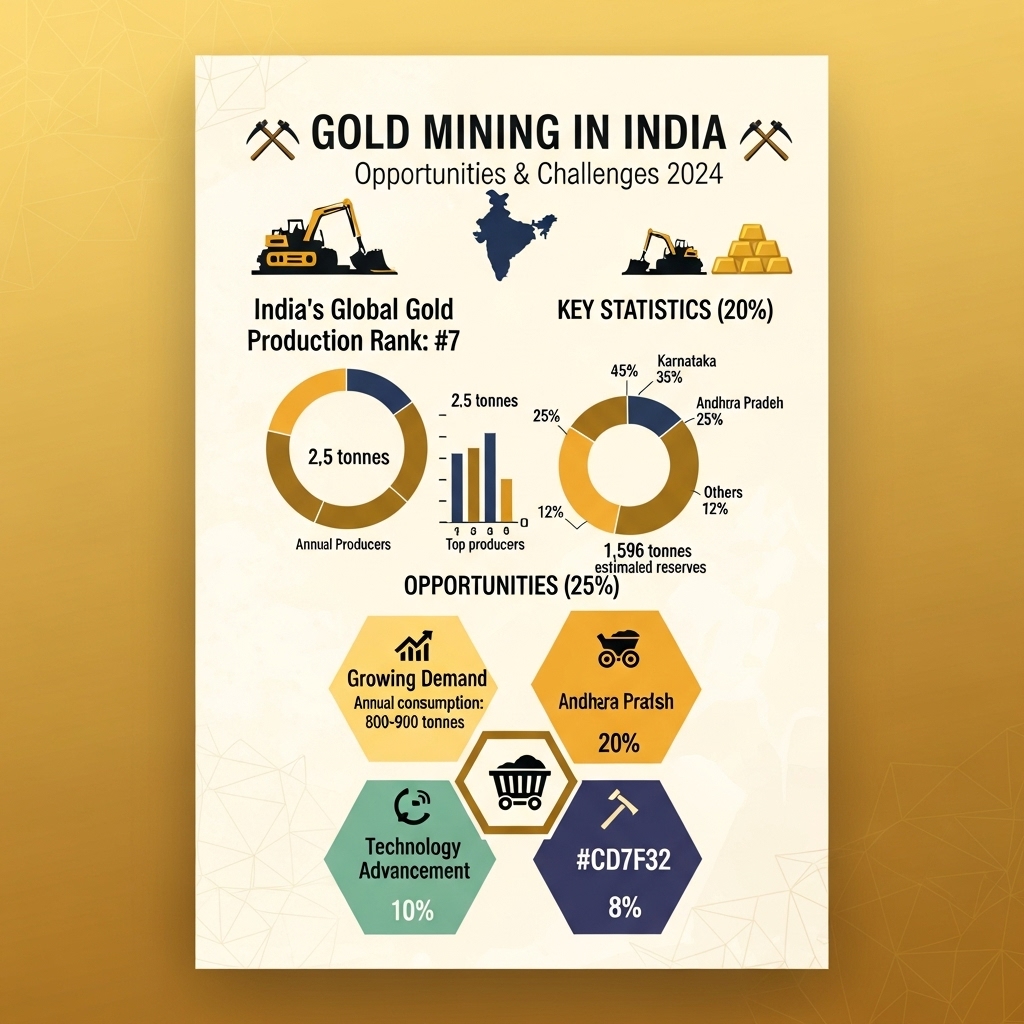Gold Mining in India: Opportunities and Challenges
As gold prices surge past $2,000 per ounce and global investors seek refuge from economic uncertainty, India’s untapped mining potential is capturing the attention of savvy precious metals investors worldwide. With over 12.6 million ounces of proven gold reserves and vast unexplored territories, India represents one of the last major frontiers for gold discovery – yet the country currently produces less than 2% of global output despite being the world’s second-largest gold consumer.
This comprehensive analysis explores the compelling investment case for India’s emerging gold mining sector, examining both the lucrative opportunities and significant hurdles that define this market. We’ll delve into India’s geological advantages, recent policy reforms that are opening doors for foreign investment, and the technological innovations driving new exploration efforts. Additionally, we’ll address the regulatory complexities, environmental challenges, and infrastructure limitations that investors must navigate.
For gold investors seeking portfolio diversification beyond traditional mining jurisdictions, understanding India’s mining landscape is crucial. The country’s growing domestic demand – fueled by cultural affinity for gold and rising middle-class wealth – combined with government initiatives to boost local production, creates a unique value proposition. Whether you’re considering mining stocks, exploration companies, or broader gold market exposure, India’s evolving mining sector offers insights that could significantly impact your precious metals investment strategy and long-term portfolio performance.
Gold Market Analysis and Key Insights
Current Market Performance and Trends
India’s gold market has demonstrated remarkable resilience, with domestic gold prices reaching ₹65,000-68,000 per 10 grams in 2024. The country remains the world’s second-largest gold consumer, importing approximately 700-800 tonnes annually. Recent data indicates a 15% year-on-year increase in gold ETF investments, reflecting growing investor confidence despite global economic uncertainties.
Digital gold platforms have revolutionized accessibility, with monthly systematic investment plans (SIPs) growing by 40% among millennials. The Reserve Bank of India’s continued gold reserve accumulation, now exceeding 760 tonnes, further validates gold’s strategic importance in India’s economic framework.
Investment Benefits and Strategic Considerations
Gold investments offer compelling advantages in the Indian context. As a proven inflation hedge, gold has historically outperformed during periods of currency devaluation and economic volatility. The asset provides portfolio diversification, typically maintaining negative correlation with equity markets during downturns.
Tax considerations favor long-term gold holdings, with capital gains tax reduced to 20% after three years for physical gold and gold ETFs. However, investors must weigh storage costs, making charges, and liquidity constraints against potential returns.
Expert Investment Recommendations
Financial experts recommend allocating 5-10% of investment portfolios to gold, emphasizing diversified approaches across physical gold, ETFs, and gold mutual funds. Market analysts suggest dollar-cost averaging through monthly SIPs to mitigate price volatility risks.
Leading investment advisors advocate for gold bonds and ETFs over physical gold for retail investors, citing lower transaction costs and enhanced liquidity. Given India’s seasonal demand patterns, experts recommend strategic accumulation during summer months when prices typically soften before festival season demand.
The consensus among market professionals indicates gold’s continued relevance as a portfolio stabilizer, particularly given ongoing geopolitical tensions and inflationary pressures. However, they caution against over-allocation, emphasizing gold’s role as a defensive asset rather than a growth investment in balanced portfolios.

Gold Investment Strategies and Options
India’s gold mining sector offers diverse investment avenues, each with distinct risk-reward profiles suited to different investor objectives and market conditions.
Physical Gold Investment remains the traditional choice, involving direct ownership of bullion, coins, or jewelry. While offering tangible security and cultural value, physical gold requires storage costs and insurance, limiting liquidity during market volatility.
Gold Mining Stocks provide leverage to gold price movements while offering dividend potential. Indian mining companies like Hutti Gold Mines and international miners operating domestically present growth opportunities. However, these investments carry operational risks, regulatory challenges, and company-specific factors beyond gold price fluctuations.
Gold Exchange-Traded Funds (ETFs) offer convenient exposure without storage concerns. Gold ETFs track bullion prices closely while maintaining high liquidity, making them ideal for tactical allocation adjustments.
Gold Futures and Options enable sophisticated strategies for experienced investors, allowing hedging and speculation with margin requirements. These derivatives require deep market knowledge and carry significant leverage risks.
Risk Assessment and Portfolio Allocation suggest limiting gold exposure to 10-15% of total portfolio value. Conservative investors should favor physical gold and ETFs, while aggressive investors might increase mining stock allocation for higher growth potential.
Market Timing Considerations indicate gold performs strongly during inflation, currency devaluation, and geopolitical uncertainty. Technical analysis suggests buying during seasonal weakness (March-May) and holding through traditional demand periods (August-December).
Comparative Analysis shows ETFs offer optimal liquidity and cost efficiency, mining stocks provide highest return potential with elevated risk, while physical gold delivers portfolio insurance with moderate carrying costs. Diversification across multiple gold investment vehicles typically optimizes risk-adjusted returns while capitalizing on India’s growing mining opportunities.
Market Performance and Outlook
India’s gold mining sector has demonstrated modest growth over the past decade, with domestic production increasing from 1.6 tonnes in 2010 to approximately 3.5 tonnes in 2023. Despite this upward trajectory, India remains heavily import-dependent, fulfilling over 95% of its annual gold demand through imports, which averaged 800-900 tonnes annually.
Current Market Conditions
The domestic gold mining industry operates in a favorable price environment, with gold prices reaching ₹60,000-65,000 per 10 grams in 2023. Major producing states including Karnataka, Andhra Pradesh, and Rajasthan have witnessed renewed exploration activities. However, India’s contribution to global gold production remains minimal at less than 0.1%.
Economic Factors and Future Outlook
Key economic drivers influencing the sector include:
– Rupee depreciation enhancing export competitiveness
– Government incentives under the National Mineral Policy 2019
– Rising domestic consumption driven by cultural affinity
– Inflation hedging demand boosting gold appeal
Market Predictions
Industry analysts project domestic production could reach 10-15 tonnes by 2030, supported by advanced exploration technologies and streamlined regulatory frameworks. However, challenges including environmental clearances, land acquisition issues, and limited geological surveys continue constraining growth potential. The sector’s success will largely depend on policy reforms facilitating foreign investment and technology transfer while balancing environmental sustainability concerns.
Frequently Asked Questions About Gold Investment
What are the main gold mining opportunities in India?
India offers significant gold mining potential with untapped reserves in states like Karnataka, Jharkhand, and Rajasthan. The government’s liberalized mining policies and increasing FDI allow both domestic and international investors to participate in exploration and extraction projects.
How do regulatory challenges affect gold mining investments?
Environmental clearances, land acquisition delays, and complex licensing procedures can extend project timelines. However, recent policy reforms have streamlined approval processes, making mining ventures more viable for serious investors.
What makes India attractive for gold investment despite challenges?
India’s position as the world’s second-largest gold consumer creates strong domestic demand. Additionally, the country’s geological diversity offers exploration opportunities, while government initiatives support mining sector growth through infrastructure development and policy reforms.
Are there alternative ways to invest in India’s gold sector?
Beyond direct mining investments, investors can consider gold ETFs, mining company stocks, gold bonds issued by the government, and digital gold platforms. These options provide exposure to gold’s performance without operational complexities.
What are the key risks in Indian gold mining investments?
Primary risks include regulatory delays, environmental compliance costs, fluctuating gold prices, and infrastructure limitations in remote mining areas.

Final Thoughts on Gold Investment
India’s gold mining sector presents a compelling yet complex investment landscape. Key takeaways include the country’s vast untapped reserves offering significant upside potential, while regulatory hurdles and environmental compliance create short-term challenges. The government’s progressive mining reforms and growing domestic demand provide strong fundamentals for long-term growth.
Investment Recommendation: Consider gold mining stocks and ETFs with Indian exposure as a strategic portfolio diversifier, but limit allocation to 5-10% given inherent volatility. Focus on established miners with strong ESG credentials and government partnerships.
The convergence of policy reforms, technological advancement, and rising gold consumption positions India’s mining sector for substantial growth over the next decade.
Ready to capitalize on India’s gold opportunity? Download our comprehensive Gold Investment Guide and subscribe to our weekly market insights to stay ahead of emerging trends in this dynamic sector.